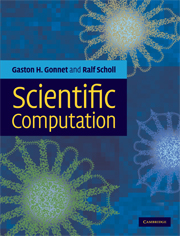Book contents
- Frontmatter
- Contents
- Preface
- List of abbreviations
- 1 Determination of the accurate location of an aircraft
- 2 When to replace equipment
- 3 Secondary structure prediction using least squares and singular value decomposition
- 4 Secondary structure prediction using least squares and best basis
- 5 Secondary structure prediction with learning methods (nearest neighbors)
- 6 Secondary structure prediction with linear programming (LP)
- 7 Stock market prediction
- 8 Phylogenetic tree construction
- Appendix A Methods for function minimization
- Appendix B Online resources
- Index
8 - Phylogenetic tree construction
Published online by Cambridge University Press: 17 February 2011
- Frontmatter
- Contents
- Preface
- List of abbreviations
- 1 Determination of the accurate location of an aircraft
- 2 When to replace equipment
- 3 Secondary structure prediction using least squares and singular value decomposition
- 4 Secondary structure prediction using least squares and best basis
- 5 Secondary structure prediction with learning methods (nearest neighbors)
- 6 Secondary structure prediction with linear programming (LP)
- 7 Stock market prediction
- 8 Phylogenetic tree construction
- Appendix A Methods for function minimization
- Appendix B Online resources
- Index
Summary
Introduction
BASIC A phylogenetic tree is a construction which describes the ancestor–descendant relations of a set of entities. When the entities are, for example, languages, the tree describes how languages have evolved. Usually the leaves of the tree represent the present-day entities (no descendants yet) and the internal nodes represent common ancestors which existed in the past. Most phylogenetic trees have an implicit notion of evolution from ancestors to current-day entities.
Phylogenetic tree construction is an important area of research in biology with applications also in linguistics, archeology, literature, mythology, history, software genealogy, etc.
Applications
Two of the most prominent examples are the tree of life and historical linguistics.
The tree of life
BACKGROUND Ancient origins A first classification scheme for animals was proposed by Aristotle, in his De Partibus Animalium around 350 BC. There he already distinguished and classified more than 500 different species in classes – with remarkable accuracy. Some of his insights were forgotten during the next 2000 years, for example that dolphins and whales are not fish since they have lungs and are viviparous.
A first classification of plants was given by Aristotle's disciple Theophrastus of Eresus in his work De Historia Plantarum about 320 BC. He classified plants as trees, bushes, shrubs etc., basing his classification on the form of growth. This method is not correct from a modern viewpoint.
- Type
- Chapter
- Information
- Scientific Computation , pp. 139 - 195Publisher: Cambridge University PressPrint publication year: 2009



